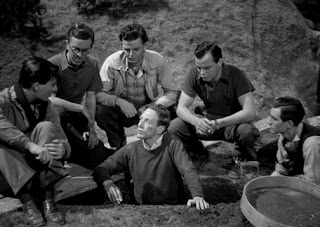Directed by Carol Reed; produced by Edward Black
It’s several months before Germany starts the Second World War by invading Poland, and she has just seized Czechoslovakia. Too late to capture Czech scientist Axel Bomasch (James Harcourt), whose work on steel could revolutionise armoured warfare, the Nazis arrest his daughter, Anna (Margaret Lockwood), to use as a hostage. The SS have a better idea, however, and plot to use Anna to lead them to her father, now in England. Despatched to foil their plan is the deceptively casual Secret Service operator Dickie Randall (Rex Harrison). Soon, move and counter-move, improvisation and impersonation put everyone - and every scheme - in danger.
Night Train to Munich is in a very similar vein as The Lady Vanishes (1938), a light international adventure story with good plotting, imaginative dialogue, fine performances and memorable characters. The similarity is not surprising, as Sydney Gilliat and Frank Launder wrote both movies; both feature trains prominently, both have top-notch directors (Alfred Hitchcock, in the case of the earlier movie) and both star Margaret Lockwood. They are different enough to enjoy on their own merits, however.
The story is pretty fast-paced, after the characters reach England, and though the plan devised by Randall to whisk the scientist and his daughter from Germany borders on the school-boyish, it is not too far-fetched, given the fact that, as Randall states, he has just forty-eight hours to effect the rescue. Like The Lady Vanishes, though, the writing’s real attraction is in the script, rather than the story.
The dialogue is crisp and snappy, and, though given to numerous characters, is tailored to those characters. Especially noteworthy are the lines given to Charters and Caldicott (Basil Radford and Naunton Wayne, respectively). Very popular in The Lady Vanishes, these two cricket-enthusiasts were carried over to this film, played by the same actors. Their dialogue is dry and droll, such as when taunted by a German Army officer about going back to England to find ‘safe jobs’ (war had just been declared.) Caldicott mutters, “What cheek! Safe jobs… As if they aren’t all taken, anyway…”
The script incorporates more realism than the story. There are several instances such as the one when a number of British civil servants (likely Secret Service officers) are sitting about discouraged, discussing the loss of the Czech scientist. In between ideas of how to salvage the situation, another gentleman comes into the room and reminds Randall’s boss of an imminent dinner-party, and his wife’s promise to bring a recipe book. Life goes on, even amid international crises.
Despite the war (perhaps because the full horror of Nazi atrocities was not yet known), Night Train to Munich shows the Germans as devoted Nazis, but also bound by the petty annoyances and restrictions of bureaucracy. Witness the station-mistress (Irene Handl), more concerned with getting passengers on and off a train than with the new war. Also, Raymond Huntley, playing an officer in the German Admiralty, seems simply trying to get through his day as easily and as untroubled as possible. This trait (along with actor Huntley) was shared in the recently reviewed movie Pimpernel Smith.
That the acting and writing work so well may be seen in small examples, such as C. V. France’s bit part as an old German admiral. His words and attitudes appear to come from an earlier age, the days of the kaiser, rather than the führer, which of course would be the case. That the film was able to convey this so clearly and concisely shows the talent involved. (And, incidentally, one learns things from old scripts, such as the fact that Berlin of 1939 had double-decker buses, and that what the British called doughnuts looked like muffins.)
Mention should be made as well of Paul von Hernried (later, better known as Paul Henreid), who plays a villain so suavely, and with enough sympathy for his enemies’ plight, that he comes across as almost likeable. The cat-and-mouse contest between Randall and Hernried’s character is highly entertaining. Also appearing in uncredited roles are Torin Thatcher, Hugh Griffiths and Ian Fleming (not the author; though, appropriately, the actor portrays a secret service official.)
All in all, Night Train to Munich is a fun ride, well-written, well-acted and well-directed.




































